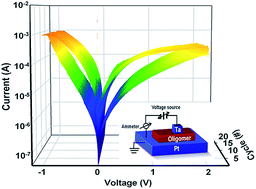Synthesis and nonvolatile memristive switching effect of a donor–acceptor structured oligomer
Abstract
As promising nonlinear dynamic electronic devices with widespread potential applications in computer data storage and neuromorphic implementations, memristors have attracted tremendous attention in both materials science and condensed-matter physics. In this work, self-rectified memristive behavior was for the first time observed in a highly soluble metal-free all-organic material containing electron-rich fluorene and dithieno[3,2-b:2′,3′-d]pyrrole moieties in the oligomer mainchain as conjugated channels for charge carriers and electron-poor 9,9-bis(3,4-bis(3,4-dicyanophenoxy)phenyl side chains in the C-9 position of the fluorene units (hereafter denoted as “PFD-8CN”). Electrical conductance of PFD-8CN can be switched between two states with a rectification ratio of ∼10, incrementally and repeatedly. Non-linear transmission characteristics of a biological synapse are also realized through consecutive multilevel conductance switchings. The novel electrical response of the device arises from electric field-induced charge transfer interactions in the donor–acceptor structured oligomer. The development of the organic memristor may offer new opportunities for the construction of molecular electronics that can greatly enhance the performance of modern computer systems.


 Please wait while we load your content...
Please wait while we load your content...